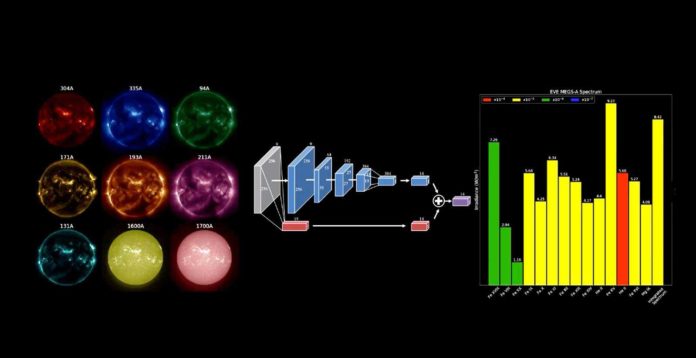It is possible to monitor Sun’s extreme ultraviolet (EUV) irradiance using deep learning. Scientists at the NASA Frontier Development Lab (FDL) have shown that deep learning can help get more value out of our current ability to monitor the Sun by providing virtual instruments to supplement physical devices.
The Sun is vital for survival, yet solar flares, which typically occurs a few times a year, can cause severe interruptions in space and on Earth. These interruptions can affect rocket, satellites, and even frameworks here on Earth, including GPS route, radio interchanges, and the power grid.
FDL team member and co-author Alexander Szenicer (Oxford University) said, “Our research shows how a deep neural network can be trained to mimic an instrument on the Solar Dynamics Observatory (SDO). By inferring what ultraviolet radiation levels that sensor would have detected based on what the other instruments on SDO are observing at any given time, we demonstrate it is possible to increase the scientific productivity of NASA missions and to increase our capability to monitor solar sources of space weather.”
During an 8-week summer research accelerator, interdisciplinary teams comprised of early-career researchers in AI and natural science domains work together to apply AI and machine learning to address important challenge questions. The challenge question behind this research was to develop an AI model using SDO images to predict solar spectral irradiance.
Traditionally, physics-inspired models were used to monitor solar EUV spectral irradiance. The models used either magnetic field distributions on the Sun’s surface or physics-based inversions of the plasma distribution in the Sun’s corona to predict EUV emission.
The new suggests the possibility of using imaging observations of the Sun to create a proxy measurement of EUV spectral irradiance.
Feeding coronal images from NASA’s SDO to a deep neural network allows us to generate proxy EUV measurements with an accuracy that surpasses physics-based models.
Additionally, the team developed benchmarks and protocols for comparing predictions between EUV models. These will be useful for future studies. Thus far, research has barely scratched the surface on what’s feasible by combining deep learning with large-scale scientific space data. Data science and machine learning will play increasingly important roles in our endeavor to understand the origins of space weather and how to live with the Sun.
